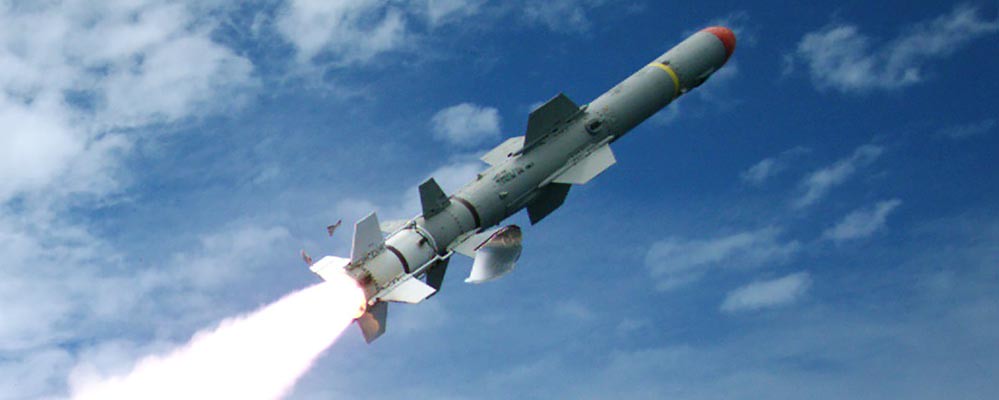Harpoon: this is the anti-ship missile delivered by Spain to Ukraine to defend against Russia
The Minister of Defense of Ukraine, Oleksiy Reznikov, has arrived in Spain today, and has pointed out a fact that had not been confirmed until now.
The information was pointed out by Reznikov during a joint press conference (see video) with the Minister of Defense of Spain, Margarita Robles. Reznikov claimed that Spain delivered Harpoon anti-ship missiles to Ukraine, which are helping to keep Russian warships away from the Ukrainian coasts. "The Spanish Harpoons right now are guaranteeing that African countries receive Ukrainian grain and thus they can survive the famine,", Reznikov said.

On Wednesday, February 22, Robles announced the delivery of "five naval systems" to Ukraine, without giving further details. That same week, and citing military sources, the newspaper La Razón pointed out that it was the Harpoon missiles, but until now there was no official confirmation. Robles has appealed to the need not to reveal information to Russia, but the reality is that this type of military shipments has caused differences between the socialist half of the government, in favor of the shipment, and the communist half, contrary to all military aid to Ukraine. The opacity of Spanish military shipments to Ukraine could seek to avoid criticism from the government's communist partners.

Personally, I think it is excellent news that Spain has sent those anti-ship missiles to Ukraine and that they have helped to keep the Russian Navy at bay, thus reducing the effects of the food crisis that Russia was trying to provoke in the African continent with its blockade of grain exports from Ukraine. Those Spanish missiles may have contributed to saving many lives, not only in Ukraine (preventing Russian attacks against its civilian population), but also in some African countries, where hunger is still a big problem.

The Harpoon was developed in the 1970s by McDonnell Douglas, now part of Boeing. It entered service with the United States Armed Forces in 1977. It can be launched from land launchers, surface ships, submarines, and aircraft. Surface-to-surface versions (land-launched and ship-launched) have a maximum range of 139 kilometers (although the most recent versions reach 278 km), while the air-to-surface version can hit targets as far as 220 kilometers (up to 315 km in the most recent versions). It is equipped with a 221 kg high-explosive warhead.

The Harpoon is a subsonic missile, equipped with a turbojet that allows it to reach a speed of 850 km/h. The naval versions also have a rocket that is activated at the time of launch. The missile is guided by radar and is equipped with a radio altimeter that allows it to fly to its target skimming the waves, making it difficult for the enemy to detect it. The naval version is bigger: it measures 4.6 meters and weighs 628 kg, while the airborne version measures 3.8 meters and weighs 519 kg.

In Spain, this missile is used by the Navy and the Air Force. The Navy has been using the naval version, RGM-84, in the Santa María class frigates (F-80) and the Álvaro de Bazán class (F-100, which uses the RGM-84 Sub-Harpoon block II version) and corvettes strong> (today patrol boats) of the Discovery class. It is possible that the submarine version will also be integrated into the Isaac Peral class submarines (S-80). Judging by the statements of Margarita Robles, Spain could have sent this naval version to Ukraine. Currently, and due to the age of the Harpoon, it is planned to replace it with the more modern Naval Strike Missile (NSM) on the "Álvaro de Bazán" (F-100) class and "Bonifaz" (F-110) class frigates.

The Spanish Air Force uses the AGM-84 Harpoon in the EF-18M Hornet fighter-bombers: "In air-to-surface missions, once launched, the missile flies towards the target area and when it is it connects its own search sensor, locates the target and destroys it without the launcher having to act again. This allows said platform to concentrate on other different threats", the Air Force points out in your website. "This missile works in conjunction with the avionics of the launching platform, which makes it possible to modify the behavior of the missile, its attack methods and multiple launches against the same target."

In addition to Spain, Denmark, the United States, Morocco, the Netherlands and the United Kingdom have also sent this type of missile to Ukraine. Through a missile of this type, Ukrainian forces sank the Russian ship "Vasily Bekh" on June 17, 2022.
---
Lead photo: U.S. navy. Launch of a Harpoon Block 1C anti-ship missile from the United States Navy littoral combat ship USS Coronado (LCS 4).
|
Don't miss the news and content that interest you. Receive the free daily newsletter in your email: |
- Most read
- The 'hole' without civil flights around Paris during the opening of the Olympic Games
- Stunning footage of the F-15QA Ababil in flight recorded from its cockpit
- The firearms used by the Pontifical Swiss Guard, the smallest army in the world
- This is the driver station of an M1 Abrams tank and the impressive start of its engine
- The first photo of an F-16 fighter with Ukrainian insignia and the details it has revealed
- Eurofighter vs F-35: the opinions of professional pilots on these advanced fighters
- The new CADPAT (MT) digital camouflage of the Canadian Armed Forces

 ES
ES







Opina sobre esta entrada: